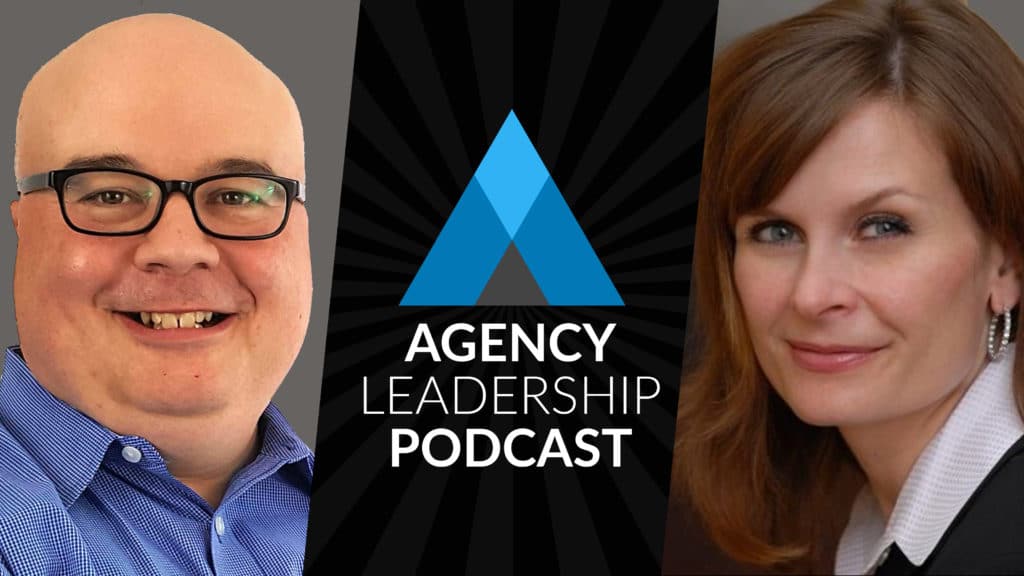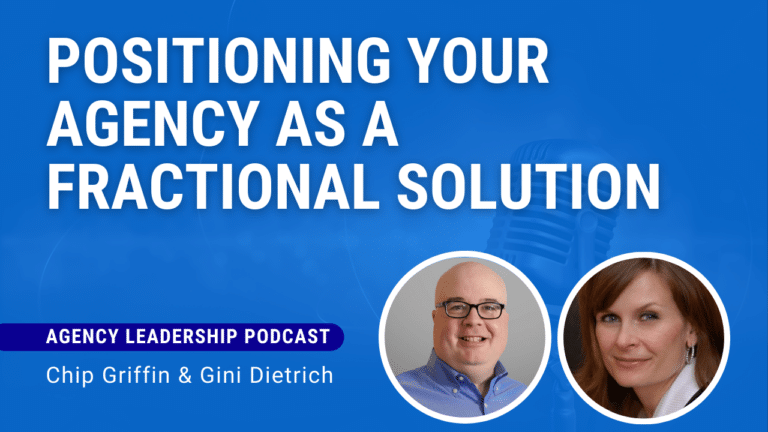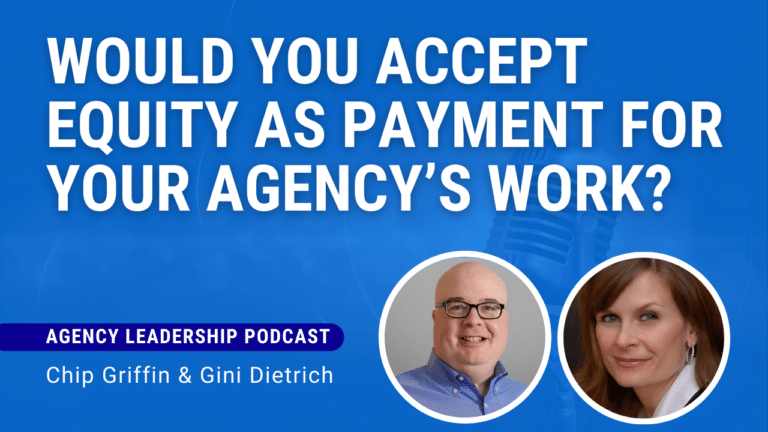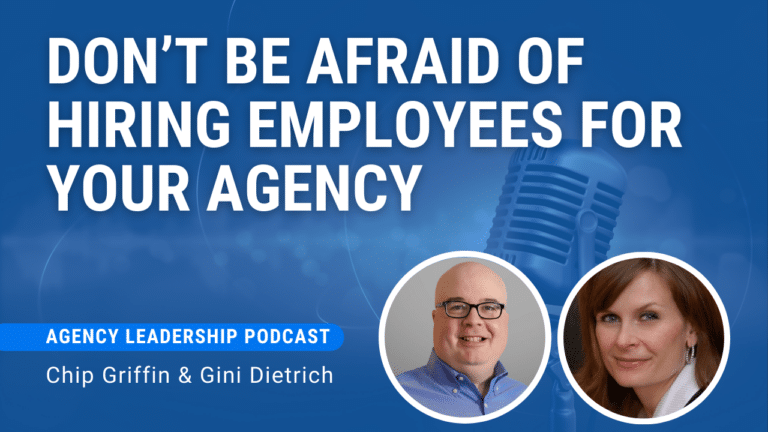Podcast: Download
A recent question on the PRSA member discussion forum came from a client who was looking for guidance on setting goals for their PR agency. The individual inquired if “3-5% [growth is] fairly standard.”
Chip and Gini tackled this question, along with the broader topic of aligning agency work with client goals. They also discussed how these goals might factor in to agency compensation.
Transcript
The following is a computer-generated transcript. Please listen to the audio to confirm accuracy.
CHIP: Hello, and welcome to another episode of the Agency Leadership Podcast. I’m Chip Griffin.
GINI: And I’m Gini Dietrich.
CHIP: And we’re here today to talk about goals. Not your goals as an agency, but the goals that your clients have for you, and how should those be set. So this is a topic that came up in the prsa discussion forum that they have on their website for members. And someone wrote in to say that she was looking for best practices when it comes to increasing the goals for our agency partner in 2020. is three to 5% fairly standard. And she goes on to say as background, we measure for both quality predetermined list of VIP outlets and quantity impressions. Our team has far exceeded the impressions goal in 2019. goes on to say what percentage are considered standard, what percentage increase should be or should the percentage increase be based on the 2019 gold or 2019 actual How should we take into account the retainer increase? Because they’ve increased the agency’s retainer by 37% monthly 2020 she says, so watch to chew on their journey. Where would you like to start?
GINI: I would like to begin with why, why? Why are we measuring goals against impressions in 2019 and 2020?
CHIP: At least it’s not a BS,
GINI: it may as well be it’s just as bad. It’s not a goal.
CHIP: Well, we probably call it opportunities to see them. That sounds much fancier OTS.
GINI: This is the thing, and this is this is this is real. They This is part of the problem with that the communications industry has overall and this is part of what we talked about, consistently at spin sucks. impressions are not a goal. impressions are not even a vanity metric. They’re not a real metric. Because you don’t know just because the New York Times has 10 million readers and you multiply that by Two and a half, and now you have 25 million impressions that all of those people have read your article. That’s just not the case. What?
CHIP: What are you trying to tell me, Jenny, that
GINI: needle in me?
CHIP: I get mentioned in the New York Times, every single person who’s ever heard of New York Times isn’t going to read and adore my quote. No. Wow. Sorry. That’s had some will for sure. My family probably I’ll send it around. I won’t even send it they won’t.
GINI: They won’t even read it. Now. They probably can send it around to you. You can I
CHIP: will read it you find something impressive. Unfortunately, it’s a negative impression by the time you’re done with it. Say Why did you say that chip? Yes.
GINI: Hi, challenge I have with this is this is a Director of Communications for a very large organization. Very large organization. And I understand that in large organizations, it takes a long time to turn the ship. I get that but If we’re talking about measuring goals and an account team that’s over servicing the client, let’s talk about the things that really mattered. And in this case, I would imagine it’s a hotel chain. I would imagine that things that matter are, you know, bodies and beds. I was trying to think of a better way to say that.
CHIP: I think the industry actually calls for the bookings.
GINI: bodies and bags won’t work butts and seats won’t work. I was literally going all right bookings. Clearly, I don’t work hospitality in this.
CHIP: Yeah, let’s go with booking streaming. I think it’s a slightly less creepy than bodies and beds.
GINI: I mean, their bodies and beds.
CHIP: Okay. Moving right along. There are there are legitimate business objectives, that in this case, you could actually more easily track that in some cases. Yes. And and I know having had some association with hospitality companies that they do, in fact, measure their public relation. activities in part by that, at least some of the companies do. You know, obviously here this is, this is different. This is not what is being measured here. And, you know, having come from a media monitoring and analysis background, I am used to having these kinds of conversations with with clients and prospects and trying to, you know, pull the thread and find out what they’re really looking for. So, the reality, though, for agencies is that clients do come to them with these kinds of, you know, goals and requests. And so, if I’m an agency leader, how do I handle that?
GINI: I will tell you how, how we handle it, and that is, we will certainly give them what they asked for and then we will show them up. It’s the stuff on top of it. So if you want us to measure impressions, okay, we’ll measure impressions but it is at the very, very, very top of the funnel and I will even label it in the reports or the dashboard. vanity metrics, I will put it under that. And then we’ll start to show the things that actually drive toward the business objectives. And eventually what happens and it’s usually after a board meeting, the client will come back and go, you don’t have to show us impressions anymore. And and then we know we’ve won. So rather than make it our idea, we try to we try to encompass what they’re looking for and what they’re used to getting. And then we show them what really matters. Right.
CHIP: I think the other the other thing that concerns me here is the linkage between the retainer rate and percentage increases in some of these numbers. Yes, because there is rarely that kind of direct linkage that ought to be taking place.
GINI: And when you and we’ve had this conversation 1000 times before and will continue to have it but when you’re providing service as a fee for a fee, you should be you should be being paid for the value that you create. And not the hours that you spend because you can’t duplicate time. So if you if I can get my job done in a half an hour, and it takes you two hours to do it, why should you make more money when I’m more efficient? Or I mean, the example I always like to use is the Got Milk campaign, they came up with this campaign and that campaign has been used for years. Do you think they get a royalty on that? Probably not. But they should. Right. So yeah, I mean, I think yes, I totally agree that attaching increasing impressions and quality of media outlets, because at to the increased budget is the wrong metric.
CHIP: Right. And the question also indicates that the the client realizes that the agency over service their account, quote, by by quite a bit, and because in that was in part because they were looking to grow the retainer. So you know, if you’re, if you’re sitting on the client side, you know that your agency is over. We’re servicing you, it’s sort of disingenuous to use that over servicing as the baseline for figuring out what future goals should be. If you’re going to tie it back to that increase, because you’re the increased, theoretically is just getting the back to where they should have been for the rate that they were doing.
GINI: Right. To begin, then there’s there’s the best the baseline versus
CHIP: right. But I mean, I think that, you know, it suggests that in this particular case, the the conversations between the agency and the client aren’t being as, as open and transparent as they need to be because the agency needs to do a better job of communicating what their value is, what their benefits are, to hopefully move off of impressions style measurement. Yeah, I would also question the wisdom of the agency intentionally over servicing, if that is indeed, what happened because intentionally over servicing and account rarely turns out the way you expect it to, because you have exactly the mindset that we see in this question which is sure you over service does. But now that’s sort of that’s the baseline of what we expect, right? And yet, you know, we’re being generous by giving you a retainer increase. Now, it’s, you’re just bringing the retainer to where it should have been for the the level and quality of work you’re receiving. So, you know, it’s it’s challenging for agencies, but they need to start with that open and transparent conversation with their clients. And they need to set the expectation that the clients will do the same, so that they can have a healthier relationship than the one that it seems like it’s being described here.
GINI: Right. There also, were there was a conversation about this in the discussion forum. And I thought a couple of comments provided some interesting insights such as, you have to look at things like what’s going on globally or nationally from a media perspective. So if you want to see that you are, that your agency is increasing impressions or you know, number of media hits, or whatever happens to be you have to look at what’s happening and right now in 2020 It is going to be an incredibly tough year to get any kind of coverage outside of the impeachment trial. Pelosi ripping up the State of the Union speech, the election what’s happening with the Iowa caucus at caucus New Hampshire primaries like you’re, it’s all going to be political everything. And so you always also have to think about it from that perspective, you know, so this is why it’s important to set goals according to objectives and not Oh, well. Okay. So you got 500 million impressions last year, and you over service does so we’re going to bring you up to where you should be. Now. 500 million is the the baseline and we want a billion impressions.
CHIP: Right? Well, I mean, this is this is like an agency setting its own business goals. purely by looking in the rearview mirror. You cannot set your future goals. Simply by looking to the past, should you use the past as a data point to include share your calculation Absolutely, but you need to look ahead and figure out what it is that you want to accomplish. How are you going to measure against that? And what’s realistic given the overall environment and that environment is not just, you know, you know, the sort of the macro things like politics, but it’s also the micro things that are specific to your business. You know, if you’re, if you’re a software company, you know, you have a big new release coming out, you got to factor that in, you know, if you if you’ve got some news generating events that you anticipate in the next 12 months, well, you know, and if you didn’t have one in the past 12 months, you’ve got to adjust your goals based on that. Um, certainly, if you had a big event, you know, if you just had a big launch last year, you got a new CEO or something like that. It’s insane to project next year’s coverage based on what you got off of a one time event the year before. So you know, you really, you know, it’s that warning that you get on investment prospectus is past performances is not an indicator of future results. Bingo.
GINI: Yes.
CHIP: Same thing here, that is not just something cooked up by the lawyers, although it certainly was cooked up by lawyers. But you know, you, you have to put all of these inputs into your thinking and then come up with a rational plan rational goals and the metrics that you’re going to use to assess how close you came.
GINI: Yeah. And I think you know, there there are a couple of people that the answer to a question the way she asked it, and then there were a couple of people that said, Hey, I don’t like impressions as a measure of success, it doesn’t indicate that that the time spent brought much value to your organization. It’s going to get harder this year. You can set a goal for that based on last year’s numbers, but you also want to look at how that’s affecting the growth of your objectives or of your organization.
CHIP: Yeah, and look, I mean, I think the you know, the other thing that this discussion raises is the importance of working with your clients to set goals. There should absolutely be goals, and I know from looking at a lot of agency, client relationships, and even more, so Recently, as part of my consulting practice, a lot of times there are not clear cut goals. Yeah, absolutely. In fact, I would say it’s probably the norm not to have well defined measurable goals for PR agency relationships with their clients. It is yes, it is typically much more of a work product based description of the scope of work. And it is typically more about just, you know, increase awareness or increase sales or you know, very bland, nondescript things that are very difficult to use as a measurement of the success of the relationship.
GINI: Yeah. And certainly there are pros and cons to it, right? I mean, I will, I will have people communicators say to me, but our job is not to increase their sales. Our job is to increase awareness and reputation. Yes. And our job is to increase sales and we do that. We just have to show how it’s working. What we’re really good at is showing that we’re that we can measure awareness and reputation. We’re not good at showing that we can measure sales. And we ask the work that we do absolutely does increase sales, we just have to prove it.
CHIP: Right. And it. I mean, what it shows is a in those cases, it is often a failure of the agency to get to the real why behind the clients decision to engage in that activity and hire that agency. And so if the if the client isn’t giving you a clear indication of what it is that they’re trying to accomplish, keep asking why keep asking more, keep digging. So if they say, you know, we want to increase our impressions, why what’s what’s the purpose? What is it? What is it going to accomplish? Because in some cases, the the internal PR department may not be that focused on sales. There are some organizations where they don’t believe that that’s the responsibility of their PR Media Relations team and they, you know, internally they’re focused on you know, that sales and marketing they need to handle that and it sort of depends. Oftentimes, you know what the org chart looks like and how these folks are being held accountable, but you need to understand what it is that the organization is trying to achieve. You need to know what the department that is hire you is trying to achieve. And you also critically need to understand what the decision maker the person who actually made the hiring decision. What are they being measured on?
GINI: Yeah, and how can you make them look good?
CHIP: Exactly, exactly. Because at the end of the day, that’s probably the best indicator of whether they’re going to keep you around. Are you helping them personally, to accomplish their objectives, their KPIs, the things that their bosses are assessing them on. And I can tell you that in my experience, very few agencies really get to the root of what that person is looking for. They think about the business or the organization and what it’s trying to accomplish, but they don’t think about that individual. And while Yes, you need to do what’s right for the overall client. You also need to do what’s right for your client contact. If you want to have A long and prosperous relationship.
GINI: Yeah. And I think in situations like that, I like to ask questions like, you know, what would What’s your biggest challenge right now and then start to dig into that. And my goal is always to ask at least 10 questions that dig into that one, one overarching broad question, just keep digging and digging and digging, and then say, Okay, if we solve that, what does it look like for you? What does it look like for your personal life? What does it look like for your professional life? How does life change for you at work? Can you go out like Do you want a promotion? Can you go after like we you just keep asking and asking and asking and asking and you can eventually get, you’re not going to get it with the first What’s your biggest challenge? You’re not gonna you’re not going to get it. But as you keep asking really smart, thoughtful questions and improve that you’re actually listening not listening to respond but actually listening. And and you can do that by the questions that follow up. When you start to do that, then they start to open up And you’ll hear things like, I can’t believe I just told you all that, or, oh my gosh, I just opened my kimono to you or I never said anything to that. Like that to anybody but my husband, you know, or my spouse. So you, you’ll hear the statements like that. And that’s when you know, you’ve gotten to the truth and you have something that you can help them do.
CHIP: Absolutely. And you really mean it’s frankly, it’s one of the benefits of the paid discovery process that we’ve talked about before on this because very few times who someone going to open up like that in the you know, the first 15 minutes of talking right? No matter how it is, you may put them with your personality. They’re simply not going to do that it’s not going to be and and so it takes time for you to figure out all of the right questions to ask. It takes time to build the rapport and to extract that and this is not a, a one time process. So even if you do have a great page discovery process and you’re digging and digging and digging, you will learn a lot you will still continue to learn things over the course of the relationship. So you need to Be prepared as an agency, to course correct. And when you’re working with clients on annual planning processes, figure out how to adjust the goals for your activities based on that. So it’s, you really can’t look at these things in isolation as the original questioner seem to be trying to do, I think and maybe in fairness to her, it may be because, you know, this is a, an online forum, and you’re just typing things out quickly. And sure, yeah, you know, and sometimes as we all know, when we write things in email, or especially on forums, it doesn’t come out the way that we really read it and a lot of facts are left out. So but you know, that said, it’s, it is really fundamental that you are constantly gathering information about your client and working to set proper expectations with them, and frankly, don’t accept the goal that doesn’t that you can’t do. Don’t just say, Sure, yeah. We’ll agree to that, you know, million impression increase next year. Yeah. You know, that’s, you can’t do that you need Push back. Because otherwise you’re setting horrible expectations that you can’t meet.
GINI: Yeah, I’m laughing because we just had the situation where a prospect told us what her goal was. And I was like, I love I love the way you’re thinking and that it’s such a big, hairy, audacious goal, but I don’t think we can deliver that for you. Right. And I had to figure out a way to say that politely and show her you know, what was more realistic. I mean, her goal is, is big and hairy and audacious, but it’s also completely unrealistic.
CHIP: Right? Well, and we absolutely have that responsibility to our clients, as agencies or agency consultants or whatever to to be honest with them. And you want your client to think big, but and people always say, you know, yeah, let’s, you know, set the set the biggest goal that you can use that what you really want and go for it. Yeah, okay. I mean, you know, I still would love to find a way to play for the Red Sox. Someday, but I think that when
GINI: you kick, can you go to their fantasy camp? You can do that. Yeah,
CHIP: I’m sad, Jenny, but not that sad.
GINI: That’s really cool. I’ve seen pictures from that stuff. It’s super cool.
CHIP: Yeah, I’m fairly sure that I wouldn’t even make the cut for that, you know, I, I’d cut them the check, I’d show up. And they’d be like, Oh, no, no, sorry, Chip, you need to move on. But that’s not I haven’t swung a bat in 35 years. I
GINI: All right, fair, you might need to do that. Like there’s a reason why I’m a little bit
CHIP: there’s a reason why I’m an umpire, not a coach
And that is that is at least one of them. So, in any case, on that note, any other thoughts on client goals for agencies that we stop
GINI: measuring impressions? That’s my final thought.
CHIP: You know, I sort of knew when I sent this one along to you that that just set you off. You know, I’ve just I, in some ways I’ve become immune to it from from my years in them
GINI: and you know which buttons to push to. You’re just like, let me just drop this in Jenny’s inbox and
CHIP: hopefully it makes for better listening. Who knows. But so that will bring to a close this episode of the agency leadership Podcast, where I will promptly shut down and go look and see the number impressions for our last episode sees no, okay. All right. On that note, I’m Chip Griffin.
GINI: I’m Gini Diedrich,
CHIP: and it depends







